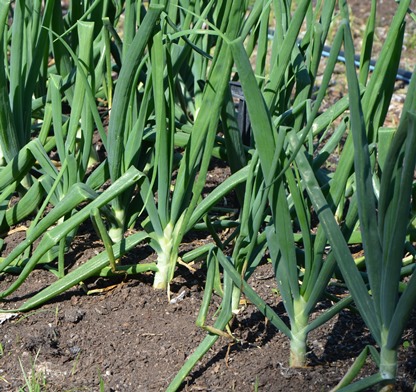
by Les Harrison | Mar 24, 2015

Onions are simple to grow and take up very little space. This is an easy selection for a beginning gardener.
The winter weather is finally giving way to springtime. While temperatures have been erratic, the rain has been sufficient.
There are still plenty of cool season leafy garden crops in production, but they will not last long as the temperatures rise.
One in-ground selection does offer some options. Onions planted last fall provide the greens and the bulb for a nutritional flavor enhancer from salads to a variety of dishes.
The common onion, Allium cepa, has many varieties within the species, and is grown and consumed worldwide. Garlic, chives and leeks are in the same genus as onions with their use similar to onions, but not nearly as frequent.
This popular and simple to grow fall vegetable easily handled the harshest north Florida winters. The multiple mornings of subfreezing temperatures and hard frost had no appreciable effect on this versatile vegetable.
Most regional soils can provide a good growing medium for onions. The lack of sulfur in the dirt and the excellent drainage are two requirements for producing a potentially mild bulb, depending on the cultivar planted.
The high levels of available phosphate in most soils also are an advantage when growing onions.
The Granex yellow onion cultivar is likely the current favorite among many gardeners. This is the same cultivar which produces some the premium branded mild onions on the market today.
Onions can be planted from August to March, either by seed or bulbs. Two inch spacing between plants provide enough space to grow and does not waste limited cultivation area.
Days to harvest depend on how the onion is to be used. Green onions, sometimes known as scallions, take four months with bulb onions taking five months or longer.In reality, onions are biennial but are usually grown as annuals.
Historical evidence of onion usage dates back 7,000 years to the Bronze Age. It is uncertain if these bulbs were cultivated or collected in the wild.
Their ease of transportation, long shelf life, and many uses made them an ideal candidate for long distance travel and trade in the days before refrigeration and high-speed movement of vegetables. Every culture and nation has its own special uses for onions.
Today’s onions provide the consumer with a combination of excellent nutrition, and good storage and handling qualities while enhancing the flavor of many meats, vegetables and salads. The bulbs come in three colors (red, yellow and white) which add to the visual quality of the dining experience.
Onions deliver vitamins B-6, C and Folic Acid. They are naturally low in sodium and fats, and contain four percent sugar.
Onions have compounds such as favonoids and phenolics which have had numerous positive health benefits attributed to them. Their consumption can be part of a healthy diet.
Properly handled onions have a potentially long storage life. Store in a cool, dry, well-ventilated area with 45 to 55 degrees the ideal temperature range.
To learn more about growing onions grown in north Florida, visit your UF/IFAS County Extension office or read the Florida Vegetable Gardening Guide.
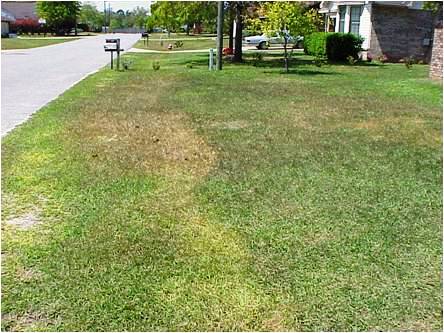
by Larry Williams | Mar 17, 2015
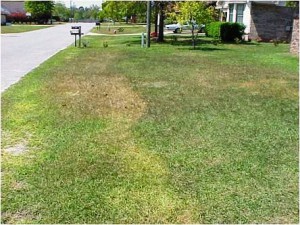
Cold injury to lawn from too early fertilizer application. Credit: Larry Williams
It’s too early to fertilize our warm-season lawn grasses now. This includes the use of fertilizers contained in weed-and-feed products.
There are a number of reasons why it’s best to wait to fertilize your lawn.
First, the soil temperature is too cool for grass roots to have access to some of the fertilizer elements. For example, iron and potassium are poorly available until the soil warms up in spring. Some nutrients leach below the grass roots because the lawn can’t use them yet. This results in waste of fertilizer, time and money.
Secondly, fertilizing too soon can induce nutrient deficiencies and off color areas in your lawn. This is one cause for bright yellow areas in lawns during early spring. Nitrogen is readily taken up by the lawn, even under cool soil conditions, and stimulates early green growth. Early lawn growth is dependent on iron also being readily available. However, iron is poorly available under the cool soil conditions of late winter and early spring. Therefore lawns turn yellow in areas due to an iron deficiency caused by an early fertilizer application. Many times, as soil temperatures warm during mid April and May, the iron becomes available and the lawn turns green. So why not avoid this scenario by waiting until mid April to fertilize your lawn?
It takes consistently warm night temperatures to allow the soil to become warm enough for best root growth and optimal uptake of fertilizer.
Thirdly, the young, tender grass roots that are beginning to grow in early spring are easily burned by the fertilizer.
Fourthly, fertilizing too early can stimulate early lawn growth, which is tender and easily injured by a late frost. The average date for our last killing frost is mid March.
Also, be very cautious about using weed-and-feed products that recommend a late winter application. These products are usually high in nitrogen, which will cause your lawn to begin growing too early. If you’re trying to control weeds, it’s best to apply your herbicides separately from fertilizer, anyway.
In North Florida, it’s best to wait until your lawn has completely greened up in spring before applying any fertilizer.
Waiting allows for more efficient use of the fertilizer. You will not injury you lawn by waiting to fertilize but you can certainly injure your lawn by fertilizing too early.
So, have patience, allow your lawn to green up on its own and then fertilize, even if it’s not until mid April or May.
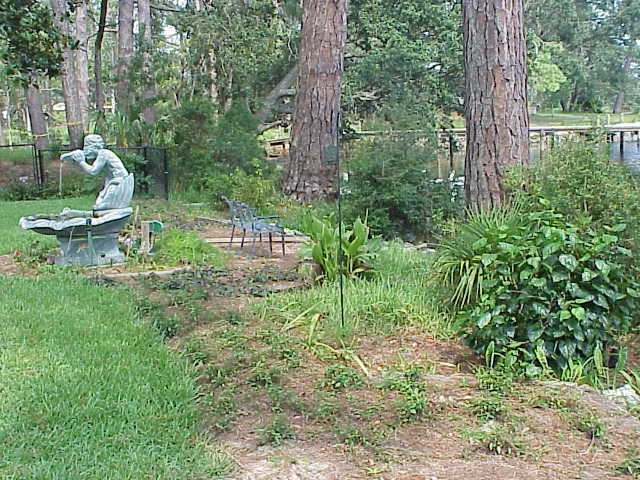
by Carrie Stevenson | Mar 17, 2015
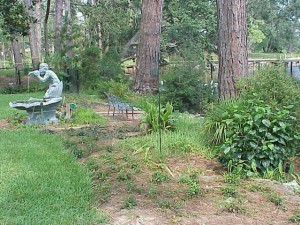
A waterfront buffer zone may include a raised berm with native vegetation to slow runoff from a yard before entering the water. Photo credit: Carrie Stevenson
A taste of spring weather has arrived, and people will soon be filling the home improvement stores and getting ready for outdoor projects. If you live on the water or near a storm drain, it’s worth considering buffer zones and best management practices for fertilizing and lawn maintenance.
A waterfront buffer zone is an area the length of one’s property line, typically running about 10 feet (although it can be wider) from the edge of a shoreline (or even a storm drain) into the yard. In this area, the homeowner allows native vegetation to grow along the water and uses low-maintenance plants within the buffer. In this zone, no fertilizers or pesticides are used. Some homeowners will build a small berm to divide the area of maintained lawn (uphill) from the downhill waterfront side. This berm may be composed of a mulched area with shrubbery to catch and filter runoff from the more highly maintained lawn. This combination of actions helps treat potentially polluted stormwater runoff before it reaches the water, and keeps homeowners from using chemicals close to the water. It is often quite difficult to grow turf next to the water, anyway, and this takes the pressure off of someone trying to grow the perfect lawn down to the water’s edge. The buffer zones are often quite attractive and can be an excellent transition between managed turf and the waterfront.
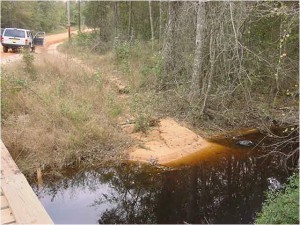
Unmaintained dirt roads along creeks are significant sources of sediment, which can harm the bottom-dwelling insects that form the base of the food web. Photo credit: Carrie Stevenson
Erosion prevention is crucial along waterways, as well. An open, non-vegetated lot can contribute a significant amount of sediment to a storm drain, stormwater pond, or natural body of water. Whether grass, trees, or bushes, any kind of vegetation is preferable to soil washing out of a yard and into the water. Sediment is a problem because it causes water clarity to drop, which can prevent seagrasses from getting the sunlight they need. Once settled, underwater sediment can form a stifling layer that chokes out small insects and invertebrates, which live in the soil and form the basis of the aquatic food chain. With no fish food available, fish may die or move out of an area. The most dramatic examples of this can often be found at dirt roads that cross over creeks. If not managed properly, the clay on these roads can nearly bury a small stream.
Other lawn care techniques for protecting the waterfront and preventing stormwater pollution include not mowing along the water, using a deflector shield and staying 3’-10’ away from the water’s edge when fertilizing, and not allowing grass clippings to blow into storm drains. Large amounts of decaying grass in a waterway can use up available oxygen, endangering aquatic organisms. When applying granular fertilizer, be sure to sweep up any spills on concrete so it doesn’t run into a storm drain. When cutting grass, mow at the highest height recommended for your turf to encourage deep rooting and stress tolerance. Healthy turf is better able to withstand drought, pests, and choke out weeds, reducing the frequency of pesticide and water application.
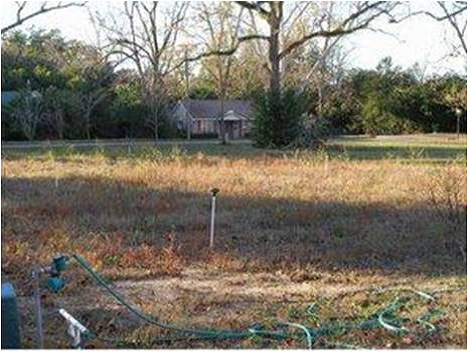
by Eddie Powell | Mar 17, 2015
Site selection of your vegetable garden is a very important part of vegetable gardening because if the appropriate site is not selected than success may be limited.
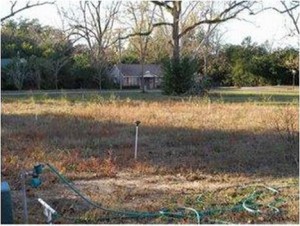
Identify distance between vegetable garden and water source. Image of a Walton County Community Garden site in DeFuniak Springs, FL.
Photo Credit: Eddie Powell
First, the gardener should place the garden in a convenient location near the house so it will be easier to maintain. The garden area also needs to be located near a good water source. Second, the gardener needs to determine how well-drained the soil is in the area and make sure that the soil is not compacted. If it is compacted, tilling will be needed to reduce compaction of the soil and help roots reach out into the soil so that optimal nutrient uptake is ensured. Third, the garden needs to be located in an area that receives at least six hours of direct sunlight daily.
Vegetable plants can be added in the landscape with other ornamental plants with proper care. Garden sites along coastal areas are also suitable places for gardens. It is good, when possible, to rotate the garden from place to place to prevent soil diseases and other pests with specific host species from accumulating in one location. One helpful tip for gardeners is to have a vegetable garden plan drawn out including the names of the plants, their location, and the dates they were planted.
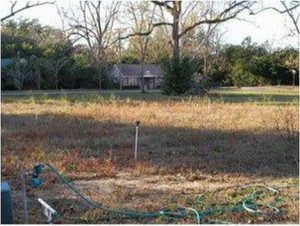
Determine how many hours of sunlight is available to the garden. Image of a Walton County Community Garden site in DeFuniak Springs, FL.
Photo Credit: Eddie Powell
Stop by your local University of Florida IFAS extension office to pick up a Vegetable Gardening Guide. It contains the dates for planting vegetables and maturity timeframes. This guide will also help you decide if you prefer ordering seeds or transplanting bought plants. If using transplants, seeds need to be sowed 4 to 6 weeks before the recommended planting date to allow time for adequate growth before transplanting. The vegetable gardening guide also includes a list of plants that do best as transplants and ones that perform better directly seeded. To learn more on this topic please feel free to stop by your local University of Florida / IFAS Extension office or visit http://edis.ifas.ufl.edu/
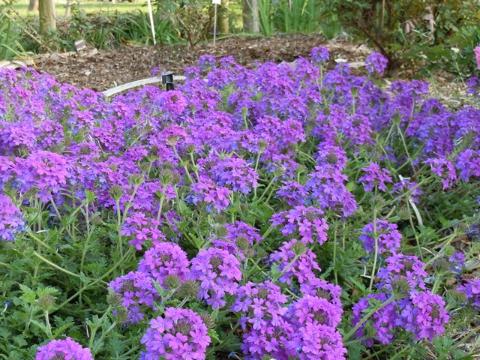
by Larry Williams | Mar 13, 2015
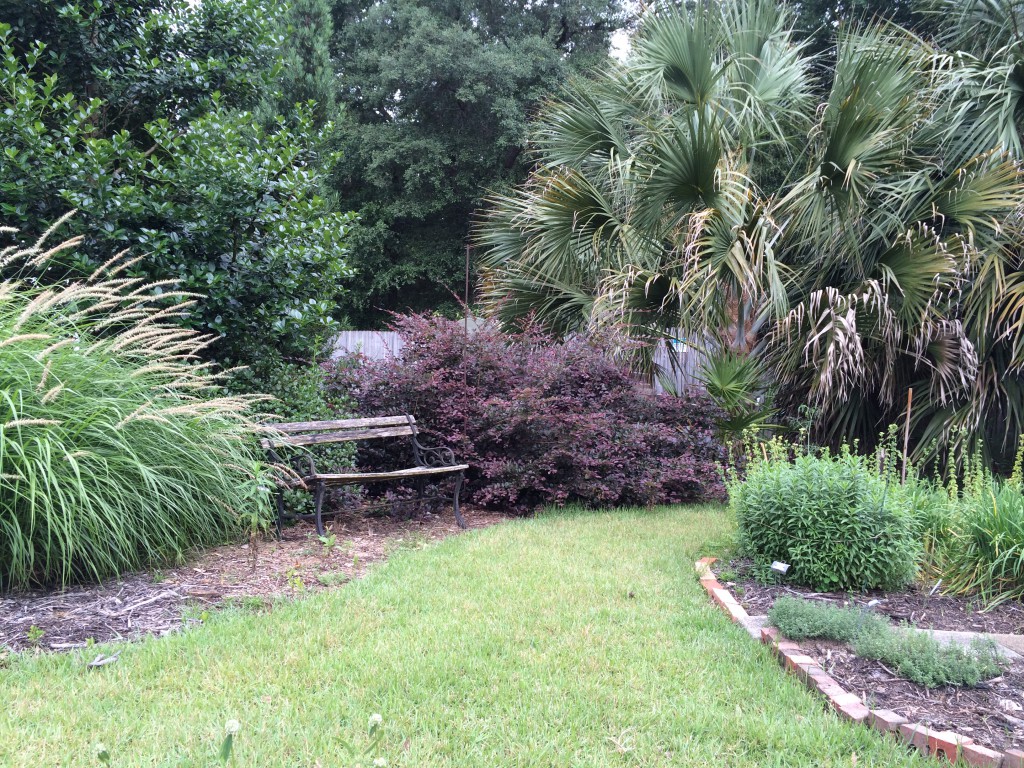
Photo by Mary Derrick, UF IFAS
Upcoming lawn & garden seminars
With spring on its way, your local University of Florida Extension Office in Okaloosa County is providing lawn and garden seminars for the public.
Plan Before You Plant Seminar: Take the guesswork out of vegetable gardening and join Okaloosa County Master Gardener Lee Vanderpool as he presents this seminar on planning your vegetable garden. Topics covered will include creating a plan for planting, interplanting and companion planting, planning for raised beds and container gardening. This is the first of our monthly seminars scheduled for the 3rd Wednesday of each month now through October. This first seminar will be held Wednesday, March 18 from10 to 11 a.m. at the Extension Annex located at 127 Hollywood Boulevard in Fort Walton Beach. For more information and to register, please call the Okaloosa County Extension Office at 850-689-5850. Space is limited.
Controlling Tomato Pests in the Home Garden Seminar: If you plan to grow tomatoes this year, plan to attend this seminar. Learn how to identify and control many of the insect and disease pests associated with growing tomatoes in the Florida home garden. I will provide this seminar on Thursday, April 2 from 9 a.m. to noon at the Okaloosa County Extension Office, 3098 Airport Road in Crestview. Please register for this program by calling the Okaloosa County Extension Office at 850-689-5850. Space is limited.
Lawn Care in Northwest Florida Seminar: I will provide this seminar as a First Tuesday Series program at the Crestview Public Library on Tuesday, April 7.
Many people become frustrated with their lawns here in Florida. Our climate, sandy soils and pest problems are unique compared to most areas of the U.S. Most people follow incorrect lawn care practices in Florida. As a result, they waste money, water, fertilizer and end up with a disappointing lawn.
This program begins at 10:30 a.m. with coffee and cookies served starting at 10 a.m. at the Crestview Public Library. The library is located at 1445 Commerce Drive (behind the Post Office). Call the library at 682-4432 or the Okaloosa County Extension Office at 689-5850 for more information.
There is no cost to attend these seminars but space is limited. So please preregister. Larry Williams, UF/IFAS Extension Agent, Okaloosa County, March 12, 2015












